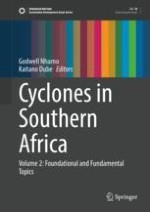2021 | OriginalPaper | Chapter
4. Revisiting Zimbabwe’s Early Warning Systems in the Light of Tropical Cyclone Idai
Authors : Sizwile Khoza, Godwell Nhamo
Published in: Cyclones in Southern Africa
Publisher: Springer International Publishing
Activate our intelligent search to find suitable subject content or patents.
Select sections of text to find matching patents with Artificial Intelligence. powered by
Select sections of text to find additional relevant content using AI-assisted search. powered by
